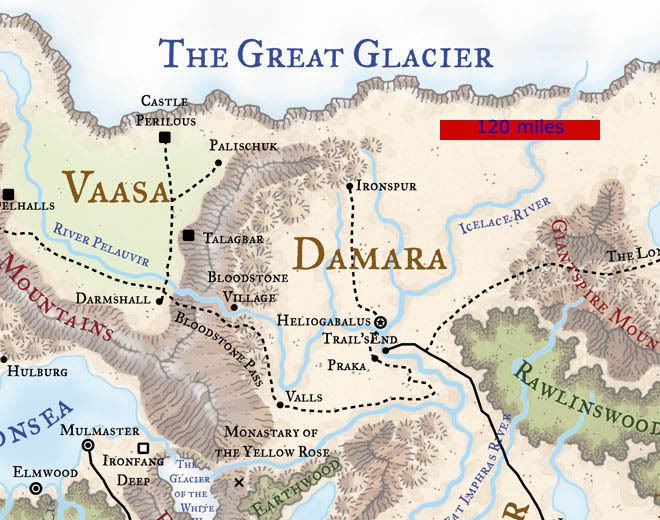Overview of the Bloodstone Lands
The phrase "Bloodstone Lands" refers to the region between the Great Glacier and Impiltur, particularly the two states of Vaasa and Damara. The whole area encompasses roughly 150,000 square miles in a roughly triangular shape, using the southern line of the Great Glacier as its northernmost boundary.
To the west, beyond the Earthspur Mountains, is the wicked land of Thar, the Moonsea, and the independent citystate of Mulmaster. To the south is Impiltur and beyond that, the Sea of Fallen Stars. To the east looms Narfell and the Great Dale.

One might assume that the nickname of this rugged region comes from the quantity of blood spilled in the area, especially in and around the Galena Mountains. There have been numerous battles with goblinkin and giantkind. The sturdy inhabitants have also faced the relentless forces of the climate, and even fought among themselves over the years. In truth, this would make "bloodstone" an apt label.
However, the phrase refers to the uncountable mineral wealth found in the area, a deep-green chalcedony flecked with red jasper. Bloodstones were once mined throughout the Galenas and the Earthspurs, luring men here in droves. Bloodstones established Damara as a major power in the Forgotten Realms.
Geography and Ecology
The Bloodstone Lands are a cold region. Freezing winds roll down from the Great Glacier and swirl through the mountain peaks, making the long winters of Vaasa and Damara longer still. Yet though their temperature ranges are similar, the geography of these two states is vastly different.
Vaasa
The northernmost of the two states, Vaasa is also the smaller. The kingdom lies in a triangular region bounded by the Earthspur Mountains, the Great Glacier, and the forbidding Galena Mountains. For centuries untold, Vaasa remained an unclaimed wasteland of frozen moors and broken clumps of tundra, a captured pocket of deep winter.
Summer does come here, if only for a few short weeks. Even then, Vaasa feels the edge of its climate.s wickedness. When the moorwaters melt and the top layers of tundra soften, the entire region becomes one vast bog of sludge and mud where "the tallest horse would wet its belly," as the saying goes in Damara.
Even more insidious, many bottomless bogs open up, particularly in the central region, above the Beaumaris River. These deadly moors would do much more than "wet a horse's belly!"
Where small farms have been scratched in Vaasa.s rocky soil, harvests show a somewhat fertile land. However, nowhere in all the kingdom has a large enough stretch of arable land been found capable of supporting a large-scale community.
Few people live in Vaasa. Even they probably wonder why.
Damara
More hospitable is the land of Damara. The hardy people of Damara get along fairly well overall, but even so, deadly winter takes its toll among the folk who live here. Summer brings a short but fruitful farming season. Game is plentiful and the rivers tame enough to be useful. Generally speaking, the lands south and east of the Galenas provide a tolerable life, if not a comfortable one.
Damara's northern border runs along the Great Glacier, while the Earthspurs demark most of Damara's western and southern border. Impiltur is an important neighbor around the southern tip of this mighty mountain range.
Natural boundaries separate Damara from Narfell to the east. Huge Rawlinswood, the Giantspire Mountains, and Icelace Lake have kept the two nations further apart than their literal proximity would seem to indicate.





























